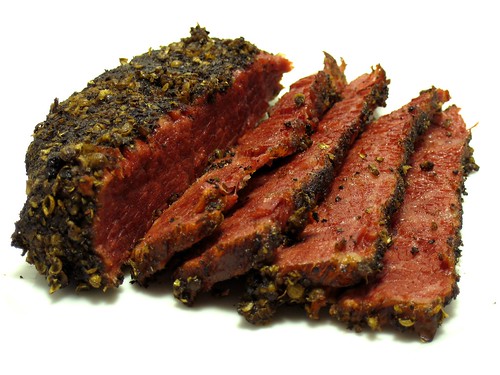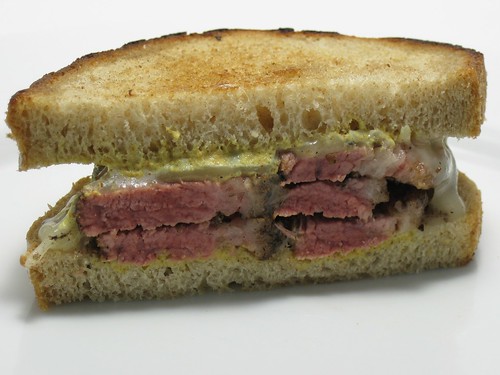
Pastrami is one of my favorite things to eat in the whole world, but it never occurred to me that I could actually make it myself until I read Asian Jewish Deli’s Pastrami Reuben post. What caught my attention was that AJD used a slab of short ribs instead of the more traditional brisket or beef plate that is used to make pastrami, and short ribs are my favorite part of the cow.

A couple months later, I was reading through Michael Ruhlman’s Ratio and in the chapter on brines, I saw a recipe for corned beef with an additional pastrami variation. I decided I would give that version a shot, especially since the dutch oven bread I made previously from Ratio turned out to really well. Ruhlman recently posted his version of short rib pastrami using regular boneless short ribs, but I kinda took the wind out of his sails a bit when I mentioned AJD’s version to him on Twitter a couple days before it went online.

of boneless short ribs. (first attempt)
The pastrami-making process is broken down into three steps: curing, smoking, and steaming. Curing is basically how you make corned beef. When you smoke and steam corned beef, you get pastrami. In fact, if you bought a prepackaged corned beef at the market, you could easily make this into pastrami, but I’d bet that doing it yourself will yield a better result.
Curing takes four days and is usually done with a wet cure, i.e. brine. Ruhlman prefers brining, especially for larger cuts of meat like a brisket. I also saw some examples on other Web sites where a dry cure didn’t penetrate all the way to the middle of the meat, so I decided to stick with a brine. After brining, the meat is rinsed, dried and then coated on all sides with a ground pepper/coriander rub before it is smoked and steamed.

The first pastrami I made used a brisket point, and it was good, but not as salty as I expected it to be. I also had a couple pieces of boneless short ribs that I threw on the brine, and those smaller pieces of meat were closer to the flavor I was looking for. Upon reviewing the recipe in Ratio, I found a typo in the recipe that affected the ratio of water to salt. I guess I could have figured out the math since tere is a specific ratio for brines, but math was never my strong suit. ;-) I mentioned the discrepancy and verified the correct ratio with Ruhlman via Twitter and proceeded to make a second pastrami a couple weeks later.
Since my goal at the outset was to make short rib pastrami, I set out to find some a slab of short ribs for the second attempt. I found one at Baron’s Meats in Alameda, but if you can’t get your hands on one, you can simply use boneless short ribs since these are easy to find at your market or butcher. Also, since boneless short ribs are smaller, they’re much easier to handle than a short rib slab or an unwieldy brisket.
PASTRAMI RECIPE
adapted from Michael Ruhlman’s Ratio
This version of the recipe corrects the typo in the first edition of Ratio and converts the corned beef recipe into dedicated pastrami variation.
INGREDIENTS
1 4-5 pound brisket, short rib slab, or boneless short ribs.
Brine
2 liters water (half gallon)
25 grams of pink curing salt* (1 ounce or 5 teaspoons)
50 grams sugar (1¼ ounces or scant ¼ cup)
100 grams kosher salt
10 cloves garlic, flattened with the flat side of a knife
1 teaspoon whole black peppercorns
1 teaspoon yellow mustard seeds
1 teaspoon coriander seeds
1 teaspoon dried red pepper flakes
1 teaspoon whole allspice
½ teaspoon ground nutmeg
1 cinnamon stick, crushed or broken into pieces
3 bay leaves, crumbled
1 teaspoon whole cloves
½ teaspoon ground ginger
* The key to preserving pastrami’s familiar red color is using pink curing salt (i.e. sodium nitrite). You can order it online at butcher-packer.com. You can omit it, but the pastrami will be brownish gray instead of red.
Dry Rub
Equal parts ground pepper and ground coriander, preferably freshly ground (enough to cover the meat)
DIRECTIONS
In a pot large enough to hold the entire piece of meat, combine all the brine ingredients in a large pot. Simmer and stir until the salt and sugar are dissolved. Remove from heat and cool to room temperature before refrigerating. When the brine is completely chilled, place the meat in the pot. Use a plate to keep the meat submerged, if necessary. Refrigerate for four days.
Remove the meat from the brine and rinse well. Dry the meat and then cover completely it in the pepper/coriander rub. Smoke the meat until the internal temperature of the meat is 165F. This will take a couple hours or so. After smoking, steam the meat for a couple more hours until tender.
If you’re eating the pastrami right away, you can remove it from the steamer and start slicing it up. If you’re not serving the pastrami right away, you can let it cool and then wrap it up in plastic wrap and refrigerate it. Cooling the pastrami also makes it easier to slice thinly if that’s how you like it. Whether you keep it whole or slice it up, steam the pastrami for 5-10 minutes to warm the meat and give it a bit more moisture before serving.
I normally prefer a traditional New York-style sandwich of pastrami on rye bread with brown deli mustard or a pastrami reuben with melted and sauerkraut (as pictured above).
